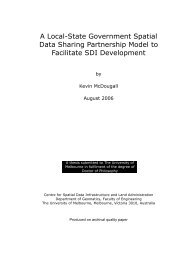The Danish Way - Centre for Spatial Data Infrastructures and Land ...
The Danish Way - Centre for Spatial Data Infrastructures and Land ...
The Danish Way - Centre for Spatial Data Infrastructures and Land ...
Create successful ePaper yourself
Turn your PDF publications into a flip-book with our unique Google optimized e-Paper software.
Digital Registers. <strong>The</strong> <strong>Danish</strong> concept <strong>for</strong> integrated l<strong>and</strong> in<strong>for</strong>mation is organised as a network of<br />
interactive subsystems containing the most relevant in<strong>for</strong>mation such as the Cadastral Register, the<br />
L<strong>and</strong> Book, the Building <strong>and</strong> Housing Register, the Communal Property <strong>Data</strong> System (property<br />
valuation <strong>and</strong> taxation), <strong>and</strong> the Central Population Register. <strong>The</strong> responsibility <strong>for</strong> the spatial<br />
in<strong>for</strong>mation registers is distributed among different public authorities at the state, county <strong>and</strong><br />
municipal level. <strong>The</strong> registers can be linked by common identifiers such as cadastral number,<br />
property identification, <strong>and</strong> geo-referenced addresses, which are maintained in the Cross-Reference<br />
Register. Fundamental to the registers was the st<strong>and</strong>ardisation of addresses in connection with the<br />
establishment of the Central Population Register. At a later stage it has been widely accepted that<br />
the address issue is of great importance when talking about spatial in<strong>for</strong>mation because the address<br />
can link data from registers containing personal, property <strong>and</strong> enterprise data sets. As all addresses<br />
in Denmark have a coordinate relating to the front door, all register data can be geo-coded to the<br />
digital map series (Br<strong>and</strong>e-Lavridsen, 2003).<br />
<strong>The</strong> contents of the key registers are available to the public through the web-based Public<br />
In<strong>for</strong>mation Server launched in 2001 (www.ois.dk). <strong>The</strong> use is free of charge.<br />
Digital Maps. In December 2000 the National Survey & Cadastre finished a nationwide vectorbased<br />
map database (TOP10DK) in a scale of 1:10,000. This map series is very important in<br />
connection with an integrated use of spatial data. <strong>The</strong> map database is designed to be used in GIS<br />
connections, <strong>and</strong> eventually the map will have different linking facilities e.g. to the property-related<br />
data. <strong>The</strong> map database includes a digital elevation model. Other topographic products in smaller<br />
scales (raster-based) are also available.<br />
Large scale digital mapping in Denmark started seriously in the 1970s in connection with the<br />
introduction of natural gas. Large scale topographic maps cover Denmark in scales from 1:1000<br />
(towns <strong>and</strong> built-up areas) to 1:10.000 (rural areas). As the maps are produced on dem<strong>and</strong> from<br />
different users (municipalities, utility companies, etc.) <strong>and</strong> in different qualities, the maps do not<br />
<strong>for</strong>m a homogenous nationwide product even if they follow the general technical specifications.<br />
Generally these maps are available on the map the service of the municipalities.<br />
<strong>The</strong> computerisation of the old analogue cadastral maps (manly in the scale of 1:4000) was<br />
completed at the end of a ten year program in 1997. <strong>The</strong> maps are designed <strong>for</strong> integrated use in a<br />
modern GIS environment.<br />
<strong>The</strong> maps are available to the public through the web-based Map Service Launched 2002<br />
(www.kort<strong>for</strong>syningen.dk). <strong>The</strong> use is based on subscription <strong>and</strong> payment. However, most of the<br />
maps are also available from the municipal <strong>and</strong> county services free of charge. Furthermore, the<br />
Plan In<strong>for</strong>mation Service was launched in 2003 (www.plan<strong>for</strong>syningen.dk) giving web-based<br />
access to various kind of planning in<strong>for</strong>mation. Again most of this in<strong>for</strong>mation is also available<br />
through the municipal services.<br />
<strong>Data</strong> Models. An important condition of utilising spatial data across public institutions <strong>and</strong> sectors<br />
(<strong>and</strong> the whole geo-data business) is that the different data can "interact". <strong>The</strong>re<strong>for</strong>e, today we have<br />
data models <strong>for</strong> property data as well as planning <strong>and</strong> environmental data. However, the<br />
documentation <strong>and</strong> metadata is often a barrier <strong>for</strong> the wider utilisation of spatial data. <strong>The</strong>re<strong>for</strong>e, a<br />
meta-database was established, see www.geoinfo.dk. <strong>The</strong> meta-database gives a short overview of<br />
each data set, where to get further in<strong>for</strong>mation about the data set.<br />
Another initiative is the COT project (Common Object Types) that attempts to point out <strong>and</strong><br />
describe common object types such as buildings, road centre lines, coastlines, etc. in topographic<br />
mapping. This way, the in<strong>for</strong>mation can be shared by all kind of end users. <strong>The</strong> project is a cooperation<br />
between the National Survey <strong>and</strong> Cadastre, the county <strong>and</strong> municipal authorities, the<br />
utility owners, <strong>and</strong> private mapping companies.<br />
7







